“Once the rockets are up, who cares where they come down?
That’s not my department,” says Wernher von Braun.
– Tom Lehrer, That Was the Year That Was (1965)
______________________________
Some time ago – in mid-September of 2017 – (time flies) I created a post focused on Sergeant Simon Fogelman of Brooklyn, who was killed in action on December 14, 1944, while serving in the 95th Infantry Division. That post – part of a continuing series about Jewish WW II military casualties in the United States’ armed forces who were reported upon in The New York Times – includes coverage of Jewish servicemen in other branches of America’s armed forces, and also includes the name of Jewish soldiers in the armed forces of other Allied nations.
And, it goes a little beyond.
That post also includes information about a British Jewish family – the Belascos, (Estelle Esther, Marion, and Sarah (Harris) Belasco) who lived in Southgate, a suburb of North London – and were among the very many British civilians killed during Germany’s V-Weapon (V-1 and V-2; Vergeltungswaffen) strikes against England during 1944 and 1945.
But, history continues.
Recently, I received this communication concerning the December 14, 1944, V-2 strike upon Southgate, from Mike in the U.K.:
Hi,
Researching the war dead from my old school, I discovered your ‘Theyweresoldiers’ site. Thank you for the information there about the Belasco family who were killed in a V2 rocket attack. If you are interested, I have further information regarding the site of that V2 blast on 14th December 1944.
You put up a google street view picture of Brownlow Road, London as the potential site of their death and I thought you might like to know that I suspect it was across the road from the picture you put up.
Most UK streets are laid out with the even numbers on one side of the road and the odds on the other, and in this case 139 was across the road. Further, pretty much all of the houses along either side of Brownlow Road are standard 1930s semi-detached pairs until you come to 139. The house that is numbered 139 stands by itself and is a later building than the others, and next to it is a decidedly post-war Synagogue. These buildings, along with the small building next to the synagogue, are the only ’young’ buildings in that section of the road and I’m pretty sure that’s because they filled a bomb site.
From various online sources, it looks like the rocket came down in the early hours of the morning on the end houses in Brownlow Road, killing outright all the occupants of 139 – the Belascos – and their neighbours at 141 – the Medens. Several other people were also killed, one at 137 which was the house to the left of 139 as you look at it from the street; one at 143 on the other side of the Medens; two at 136, which is across the road from them, and another person who may have been a passerby as no address is given for them. Records indicate that five buildings were demolished, either directly by the explosion or subsequently as they were beyond repair.
It might be just coincidence that a synagogue was built on the site of the attack after the war, but whether it was or not it is very fitting, is it not?
Thank you for your work in putting together your sites. Have a good day.
Prompted by Mike’s informative message, I searched the Commonwealth War Graves Commission’s database for information about civilian casualties incurred on the 14th of December, and – just as Mike wrote – verified the tragic loss of several members of the Meden family, and other civilian casualties, as well.
The missile, fired by Versuchsbatterie 444 from Hoek van Holland at 02:10 hours local time – 2:10 A.M. – was one of the 26 V-2 rockets launched on December 14, 1944. Another V-2, fired by the same Batterie at 17:15 Hours (5:15 P.M.) struck Southwark and killed 12 people.
The four members of the Meden family were Florence Constance and her three children, Dorothy, Reginald Edward, and Louisa May. One person – Ethel Davis, 53 years old – died at 136 Brownlow Road, while the person at 137 Brownlow Road was Annie Scott Harvey (born 1886). The two people at 143 Brownlow Road were Able Seaman Henry William Herbert and his wife, Mildred Katherine Adelaide Herbert. The “passerby” was probably Olive Clayden Smith, 55 years old, for whom no residential address is given.
Specifics about these nine people – may they rest in peace – appear below:
Davis, Ethel
Born 1891
(Of 136 Brownlow Road)
Daughter of the late William Charles and Nellie Davis
Died at 136 Brownlow Road
Harvey, Annie Scott
Born 1886
(Of 137 Brownlow Road)
Daughter of Harry Harvey, and of the late Jane Ann Scott Harvey
Died at 137 Brownlow Road
Herbert, Mildred Katherine Adelaide
Born 1924
(Of 143 Brownlow Road)
Wife of Able Seaman Henry William Herbert, R.N.
Daughter of Bertha Souemans, of 3 Endwood Court Road, Birmingham
Died at 143 Brownlow Road
Herbert, Henry William, Able Seaman, C/JX566996
Royal Navy, H.M.S. Goodall
Born 1915
Husband of Mildred Katherine Adelaide Herbert
Son of Francis Victor and Sophia Lilian Herbert, of Kentish Town, London
Died at 143 Brownlow Road
On tombstone: “ALSO HIS WIFE MILDRED K.A. HERBERT AGE 20 KILLED WITH HIM BY ENEMY ACTION”
Meden, Florence Constance
Born 1863
(Of 141 Brownlow Road)
Widow of Edward Meden
Died at 141 Brownlow Road
Meden, Dorothy Constance, W.V.S.
Born 1887
(Of 141 Brownlow Road)
Daughter of Florence Constance Meden, and of the late Edward Meden
Died at Brownlow Road
Meden, Reginald Edward, Home Guard
Born 1893
(Of 141 Brownlow Road)
Son of Florence Constance Meden, and of the late Edward Meden
Died at 141 Brownlow Road
Meden, Louisa May
Born 1901
(Of 141 Brownlow Road)
Daughter of Florence Constance Meden, and of the late Edward Meden
Died at 141 Brownlow Road
Smith, Olive Clayden
Born 1889
Daughter of Gertrude M. Smith, of The Ridgeway, Woodingdean, Brighton, Sussex, and of the late John H. Smith
Died at Brownlow Road
______________________________
Here’s a 2017 Oogle Map of the general area of Southgate, with Oogle’s red pointer designating 139 Brownlow Road.
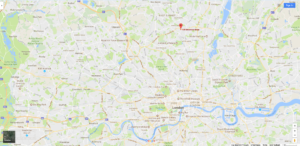 This Oogle Street View – created for my original post of September, 2017 – shows residences and a bus-stop along the “even-numbered” side of Brownlow Road, which are actually opposite (oops!) the location of 139 Brownlow Road. (I was unfamiliar with the address numbering system when that post was created.)
This Oogle Street View – created for my original post of September, 2017 – shows residences and a bus-stop along the “even-numbered” side of Brownlow Road, which are actually opposite (oops!) the location of 139 Brownlow Road. (I was unfamiliar with the address numbering system when that post was created.)
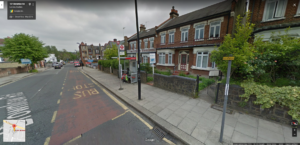 Here’s an Oogle Street View of the above location, albeit taken from a different angle and captured in July of 2019.
Here’s an Oogle Street View of the above location, albeit taken from a different angle and captured in July of 2019.
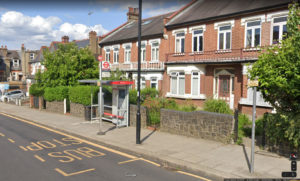 This Street View shows the opposite – “odd-numbered” – addresses on Brownlow Road, progressing left to right from number 141, to 139, to 137. Mike is absolutely correct: The architectural style of address 139 is distinctly different from other dwellings on the street, while a synagogue (not apparent as such from the street view) is located at address 137.
This Street View shows the opposite – “odd-numbered” – addresses on Brownlow Road, progressing left to right from number 141, to 139, to 137. Mike is absolutely correct: The architectural style of address 139 is distinctly different from other dwellings on the street, while a synagogue (not apparent as such from the street view) is located at address 137.
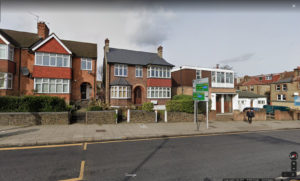 The schul turns out to be the appropriately named Palmers Green & Southgate Synagogue. A view of the synagogue’s beautiful interior appears below…
The schul turns out to be the appropriately named Palmers Green & Southgate Synagogue. A view of the synagogue’s beautiful interior appears below…
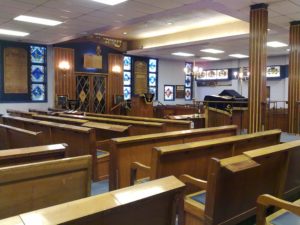 Here’s the Synagogue’s history, as taken from the PGSS website.
Here’s the Synagogue’s history, as taken from the PGSS website.
The History of Palmers Green & Southgate
The Palmers Green Kehilla fits into the classic pattern of the rise of Jewish suburbia. Meeting in the early days (circa 1926) in various houses under the guidance of Rev. A.L. Lewin, an unofficial Minister to the then outlying suburban communities, the congregation became affiliated to the United Synagogue in 1934. To meet the needs of the then growing community, the present Brownlow Road site was purchased, and a synagogue was built and consecrated by the Chief Rabbi Joseph Hertz on the 10th May 1936. The synagogue building was virtually destroyed in an air raid on the 13th December 1944, but plans were immediately put in hand to rebuild the synagogue and this was completed in 1947. Some years later further works were carried out to provide a communal hall and kitchen at first floor level and the rear ground floor section which had served as the communal hall, was converted into the present day ladies gallery.
The setting up of Hebrew Classes was treated as a priority from the very early days, and by the time of the first synagogue consecration and with a membership of 147, 35 boys and 7 girls were enrolled. This number was to grow to a peak of over 300 by the 1960s.
Serving the community has been a feature of the Kehilla. Apart from those who gave their lives in the second World War and the Yom Kippur War, various congregants have served as Mayor of the local principality, as Head Teachers of Jewish Schools, and Honourary Officers of the United Synagogue.
Serving the Kehilla as minister have been Rabbi I. Chait (a Chaplain in the Forces), Rabbi F.F. Carlbach, Rabbi J.S. Shaw and currently Rabbi E. Levy. Services over the years have been enhanced by Chazanim who include Rev Domowitz, Rev. Binstock and for over twenty years by Rev Brian Segal.
Likewise the community has been blessed with the dedication of several members who have acted as Warden, including the present Life President, Mr. Sidney Goldschneider. The synagogue has benefitted from the sterling work of both Mr. A. Philips and also, until his recent retirement of Mr. Martin Lewis who have held the post of synagogue Secretary/Administrator.
In 1977, as part of its Golden Jubilee celebrations, the Kehilla initiated the Jewish Way of Life Exhibition, which, in its updated version has now visited communities throughout the country.
Past distinguished worshippers have included Mrs. Ruth Winston-Fox MBE, Lord Robert Winston, Dr. Anthony Julius, Professor I. Finkel, Rev A Greenblatt OBE and Mr. Clive Lawton.
Noted for its warmth towards visitors and its pleasing atmosphere, the Palmers Green community, now 70 years on, strives to fulfil its role by continuing to provide daily, Shabbat and Festival services and a programme of activities for its members.
The synagogue would like to thank Mr. Alan Grant for providing this brief history of the Palmers Green Community.
And, a comment…
Based on the above history, the present Palmers Green & Southgate Synagogue was evidently constructed at the location of a prior synagogue, built in 1936. That first schul seems to have been the actual impact point of the V-2 which killed the Belascos, Medens, Herberts, Davis, Harvey, and Smith on December 14, the date of “13th December” evidently being incorrect.
So, Mike is more than correct in his observation, “It might be just coincidence that a synagogue was built on the site of the attack after the war, but whether it was or not it is very fitting, is it not?”
It is. Entirely so.
______________________________
Gather round while I sing you of Wernher von Braun,
A man whose allegiance
Is ruled by expedience.
Call him a Nazi, he won’t even frown.
“Nazi Schmazi,” says Wernher von Braun.
Don’t say that he’s hypocritical,
Say rather that he’s apolitical.
“Once the rockets are up, who cares where they come down?
That’s not my department,” says Wernher von Braun.
Some have harsh words for this man of renown,
But some think our attitude
Should be one of gratitude,
Like the widows and cripples in old London town
Who owe their large pensions to Wernher von Braun.
You too may be a big hero,
Once you’ve learned to count backwards to zero.
“In German oder English I know how to count down,
Und I’m learning Chinese,” says Wernher von Braun.
References, Wherefroms, and What-Not
Palmers Green & Southgate Synagogue, at PGSS
Timeline for V-2 Rocket Attacks, at V2rocket.com
Tom Lehrer Lyrics, at All The Lyrics.com
Tom Lehrer Album “That Was The Year That Was”, at Wikipedia
